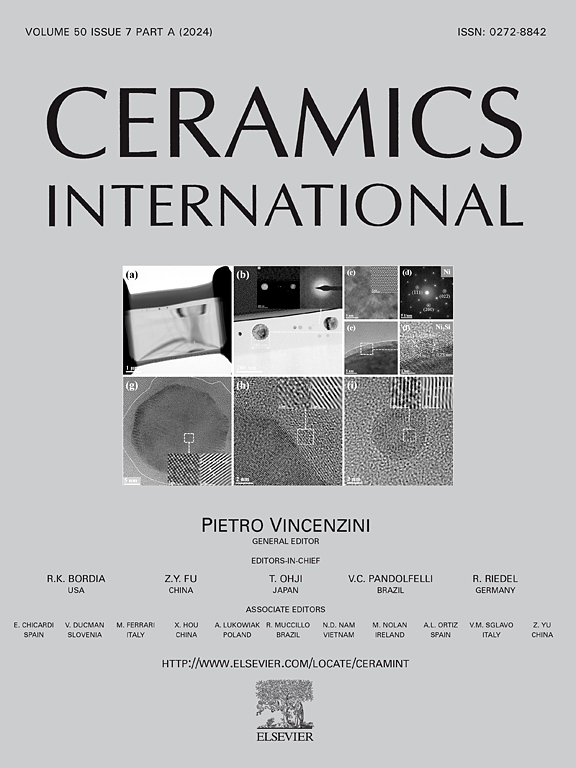金刚石薄膜上生长的氧化镍装饰氧化锌纳米棒的电子场发射特性
IF 5.6
2区 材料科学
Q1 MATERIALS SCIENCE, CERAMICS
引用次数: 0
摘要
氧化锌/微米金刚石(MCD)复合结构结合了两种宽带隙半导体材料,性能稳定,适用于在各种复杂环境中工作的高性能电子场发射(EFE)器件。然而,氧化锌在光学和电化学方面的局限性限制了其有效性。通常情况下,氧化镍可以弥补氧化锌的这些固有缺陷,从而提高场发射器件的性能。本研究采用水热/溶胶凝胶两步法在金刚石表面制备了氧化镍装饰的氧化锌薄膜。研究深入探讨了醋酸镍溶液造成的不同镍掺杂浓度对场发射特性的影响。此外,本研究还制作了氧化镍装饰的氧化锌/微米金刚石异质结复合结构,探讨了该结构对器件光电性能的影响。ZnO纳米棒之间形成的NiO薄膜中掺杂的Ni浓度增加,掺杂的Ni以Ni2+和Ni3+两种形式存在于ZnO/MCD复合结构中,而Ni2+和Ni3+是半导体电子器件的重要材料。氧化镍装饰过程在纳米棒阵列结构的带隙内产生了缺陷水平,从而提高了氧化锌的光致发光性能。此外,氧化镍和氧化锌之间的相互作用促进了界面上 p-n 结的形成,从而产生了内部电场。这种电场极大地改善了氧化锌的电流传导场和最大电流密度,从而提高了其电场发射性能。在所有测试样品中,掺杂浓度为 0.1M 的氧化锌纳米棒的光学和电学特性最为出色。掺杂浓度为 0.1 M 时,开启电场的最小值为 0.96 V/μm,最大电流密度 J 的最大值为 2.54 mA/cm2。这些结果为推动集成宽带光学器件的发展提供了新的启示。本文章由计算机程序翻译,如有差异,请以英文原文为准。
Electron field emission property of NiO-decorated ZnO nanorods grown on diamond films
ZnO/micron diamond (MCD) composite structure combines two wide-band gap semiconductor materials, providing stable performance suitable for high-performance electron field emission (EFE) devices operating in various complex environments. Nonetheless, the optical and electrochemical limitations of ZnO constrain its effectiveness. Typically, NiO can compensate these inherent defects in ZnO, thereby enhancing the performance of field-emitting devices. In this research, NiO-decorated ZnO thin films were fabricated on diamond surfaces using hydrothermal/sol-gel two-step method. The impact of varying Ni doping concentrations caused by nickel acetate solutions on the field emission properties was thoroughly investigated. Furthermore, this study involved the fabrication of NiO-decorated ZnO/micron diamond heterojunction composite structures, exploring the impact of the structure on the optoelectronic performance of the devices. The Ni doping concentration increases in the NiO films formed between the ZnO nanorods, the doped Ni exists in the ZnO/MCD composite structure as both Ni2+ and Ni3+, which are important materials for semiconductor electronic devices. The NiO decoration process induced the creation of defect levels within the bandgap of the nanorod array structure, consequently enhancing the photoluminescence performance of ZnO. Furthermore, the interaction between NiO and ZnO facilitated the formation of a p-n junction at the interface, generating an internal electric field. This electric field significantly improved the current conduction field and maximum current density of ZnO, thereby enhancing its electric field emission performance. The optical and electrical properties of ZnO nanorods doped at 0.1M exhibited the most favorable characteristics among all tested samples. At a doping concentration of 0.1 M, the turn-on electric field reaches a minimum value of 0.96 V/μm and the maximum current density J reaches a maximum value of 2.54 mA/cm2. These results offer novel insights for advancing the development of integrated broadband optical devices.
求助全文
通过发布文献求助,成功后即可免费获取论文全文。
去求助
来源期刊

Ceramics International
工程技术-材料科学:硅酸盐
CiteScore
9.40
自引率
15.40%
发文量
4558
审稿时长
25 days
期刊介绍:
Ceramics International covers the science of advanced ceramic materials. The journal encourages contributions that demonstrate how an understanding of the basic chemical and physical phenomena may direct materials design and stimulate ideas for new or improved processing techniques, in order to obtain materials with desired structural features and properties.
Ceramics International covers oxide and non-oxide ceramics, functional glasses, glass ceramics, amorphous inorganic non-metallic materials (and their combinations with metal and organic materials), in the form of particulates, dense or porous bodies, thin/thick films and laminated, graded and composite structures. Process related topics such as ceramic-ceramic joints or joining ceramics with dissimilar materials, as well as surface finishing and conditioning are also covered. Besides traditional processing techniques, manufacturing routes of interest include innovative procedures benefiting from externally applied stresses, electromagnetic fields and energetic beams, as well as top-down and self-assembly nanotechnology approaches. In addition, the journal welcomes submissions on bio-inspired and bio-enabled materials designs, experimentally validated multi scale modelling and simulation for materials design, and the use of the most advanced chemical and physical characterization techniques of structure, properties and behaviour.
Technologically relevant low-dimensional systems are a particular focus of Ceramics International. These include 0, 1 and 2-D nanomaterials (also covering CNTs, graphene and related materials, and diamond-like carbons), their nanocomposites, as well as nano-hybrids and hierarchical multifunctional nanostructures that might integrate molecular, biological and electronic components.
 求助内容:
求助内容: 应助结果提醒方式:
应助结果提醒方式:


